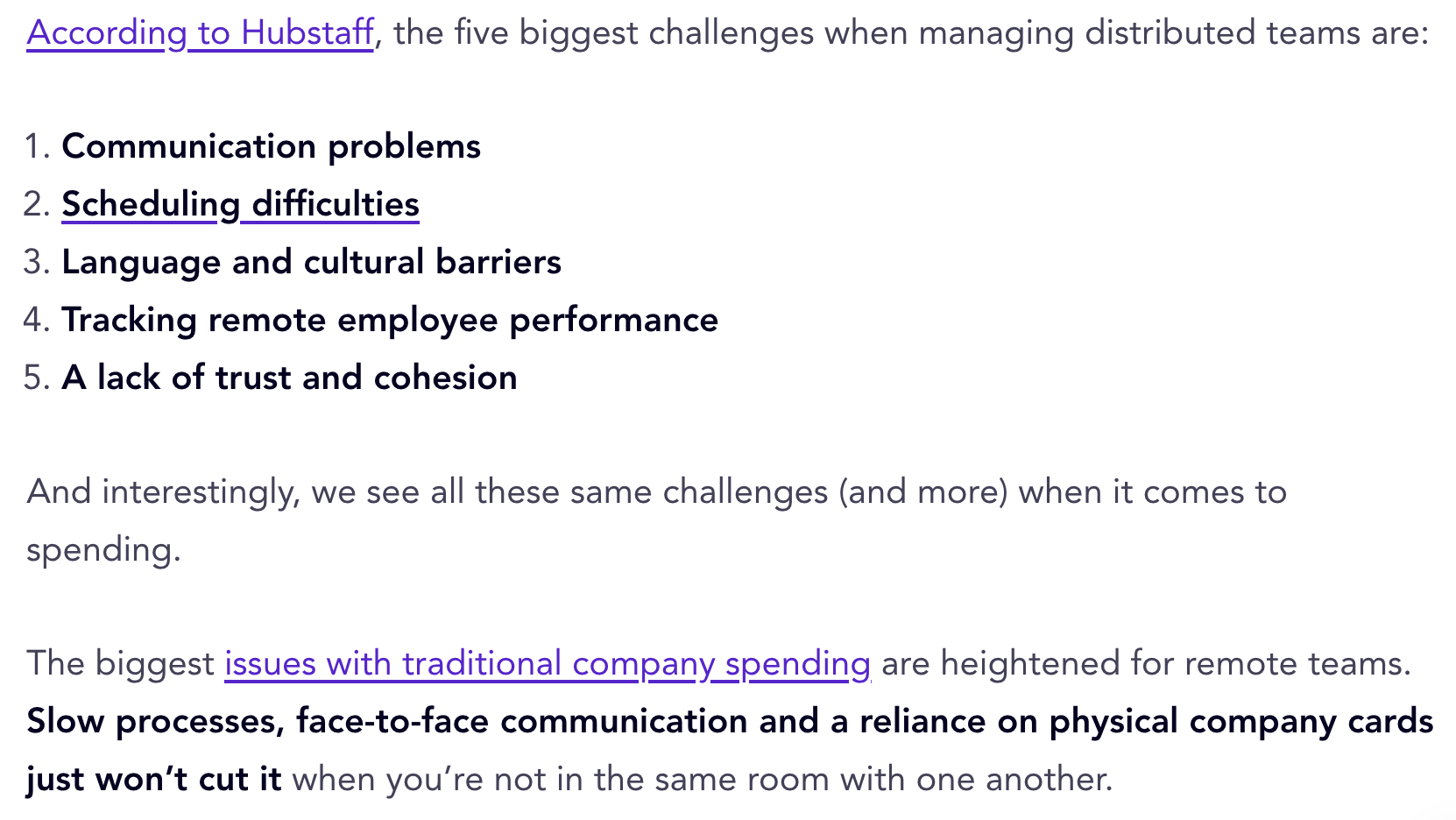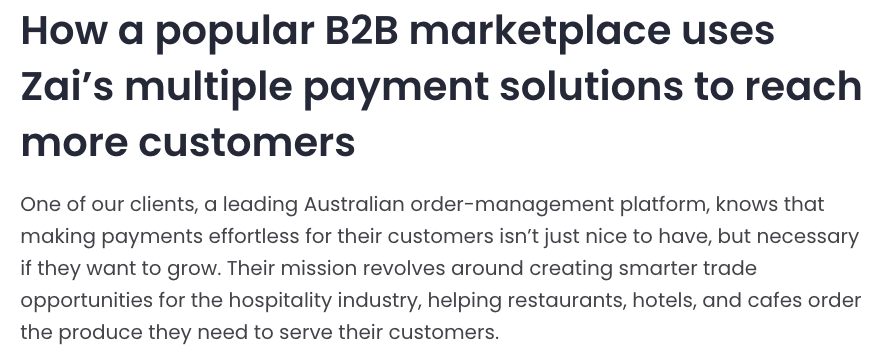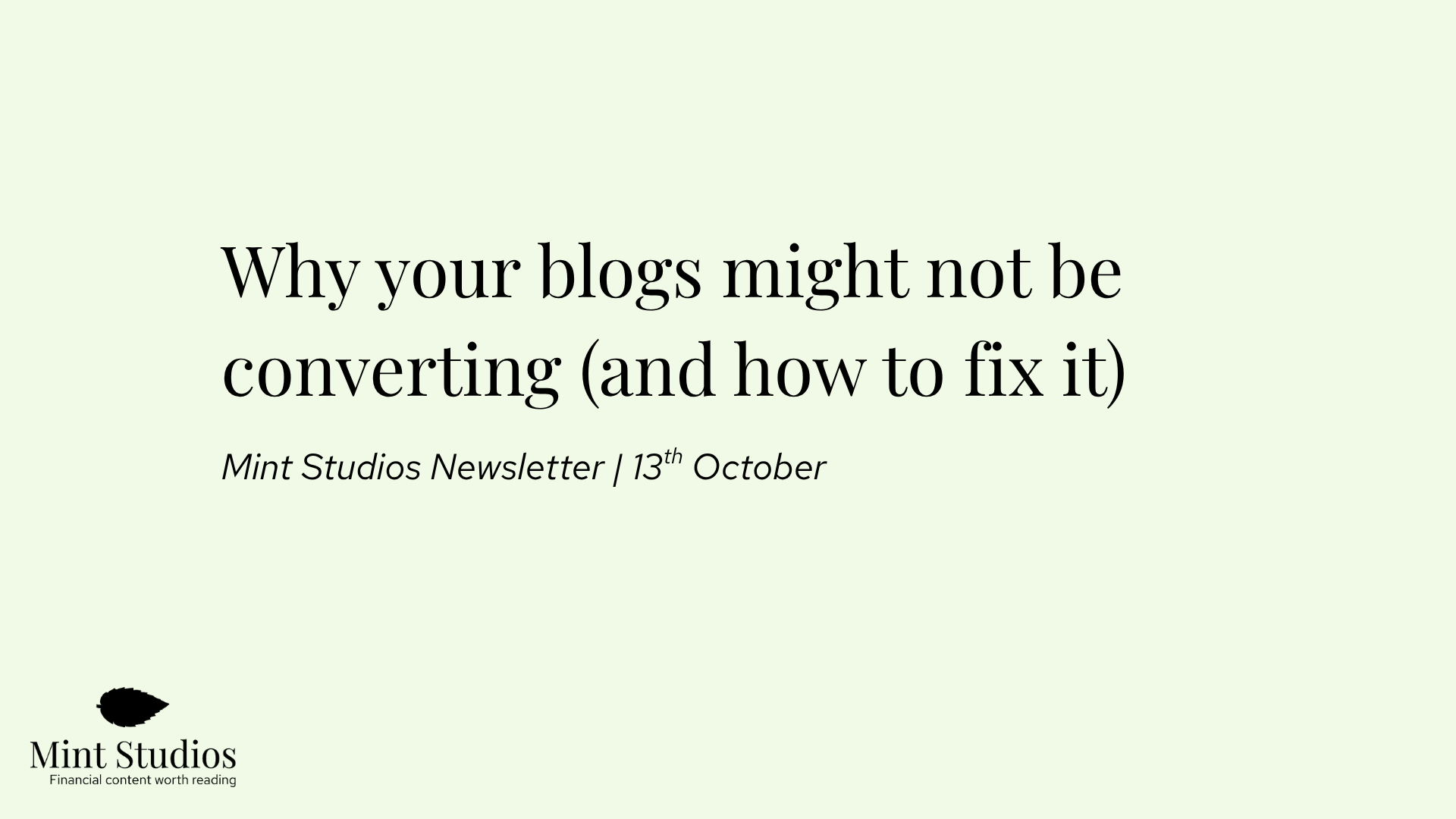Whether you’re a freelance, in-house or part of an agency, when it comes to fintech copywriting you may find yourself in one of these situations:
- You’re figuring out ways to make writing about fintech easier. Fintech is more technical and complex than other industries, which makes it a bit harder to write about.
- You might be looking for resources to learn more about the fintech startups and get a better understanding of specific financial concepts.
- Your client or employer wants you to write content that contributes to the bottom line, and you’re trying to figure out how to do that.
At Mint Studios, we’re a content marketing agency that focuses on the fintech industry. Specifically, we help fintech companies turn their website blog into a customer acquisition channel.
Our founder, Araminta, used to be an in-house and then freelance fintech writer. Everyone on the Mint team is a fintech writer, and with our methodology we’ve helped many fintech companies create content that’s generated $10M+ in business opportunities.
We’ve also hired many writers over the years, and trained every person we hired to write on fintech. Which means that over the years, we’ve learnt a thing or two about copywriting and fintech.
Here are 8 tips for copywriters, content marketers and fintech marketers on how to write about fintech.
Note: want to get an update every time we write a new article? Join our newsletter – we send it every 2 weeks solely on the topic of fintech and content marketing.
1. Make sure each piece of content has a purpose (which is not traffic)
One of the biggest mistakes we see copywriters, marketers and teams make is writing a piece of content without a clear purpose.
We see too many people create content to rank on Google and generate traffic. That might make sense if you’re a publisher or magazine, but as a fintech company, this isn’t an objective that makes sense.
Simply because: an increase in traffic does not equal an increase in sales. As a company, your objective is always acquiring customers, not pageviews.
This is especially true if you are in B2B and you are targeting a very small niche. Quantity shouldn’t matter – quality matters. What matters is targeting the right people.
You may argue that as a copywriter, that isn’t your job. Although that’s partially true, we know from experience that it is a lot easier to write a good piece of content if you know what the purpose of the article is.
If you know the article is going to drive customers, you’ll want to add more CTAs and include details about the product. If the article is supposed to support the sales team, then you need to write in a style that assumes the reader already knows about your company. If the article is to be promoted on social media, then you’ll want to make the introduction as catchy as possible.
As the copywriter, push hard to have a primary objective for each piece of content. Ask the strategist to add an objective on your content brief or calendar that everyone agrees to.
And once you have a purpose, what’s the strategy? How will this piece of content help the company get customers? How will you get it in front of the right people? How will it raise brand awareness? Make sure someone is thinking about how this piece of content will help achieve that objective and will execute on it.
Sure, with content you can’t measure everything. But publishing something, crossing your fingers and hoping it’ll work is not a strategy to succeed with content.
As a copywriter, writing a piece that has a clear objective will make it easier to write great content. And demonstrating the fact that you’re thinking about strategy will also get you a seat at the marketing table.
2. Spend time understanding the product, market and customer
One of the key reasons a lot of finance and fintech content falls flat is because the content writer doesn’t understand the customer pain points. It’s one of the main reasons we believe that the traditional way fintech companies work with freelancers doesn’t work.
When companies create content like this, it’s obvious that the person writing this doesn’t understand pain points:

If you’re a freelancer offering copywriting services, you need to spend upfront time (and bill for it) understanding your customer pain points, the product and market. If you work full-time and in-house, spend the first month when working for the company understanding what they do.
You may like: How to Create Content that Speaks to Your Customers' Pain Points
Here are some tips on how to learn about each part of the company:
To learn about the product, you can:
- Ask for a product demo so they can show you how your product works.
- Ask to read product documentation.
- Get on a one on one call with a product person to ask questions about the product.
To learn about the company’s ideal customer, you can:
- Watch customer success calls or interviews with the customer.
- Get on a one on one call with a salesperson and ask questions about your target audience.
- Ask for emails/sales enablement docs to read.
To learn about the market, you can:
- Ask for resources on your market (e.g. if it’s payments, share payment publications, podcasts, etc with them)
When we work with a new client, we spend a month understanding their product, customer base and market. It’s impossible to put together a content strategy (and create great content, in our opinion) without doing all the upfront research. You can learn more about our approach here: How to Do Research for Bottom of the Funnel Content Marketing
Whether you’re in-house or freelance, we recommend doing the same. Without spending time understanding who you’re writing for, their pain points and how this relates to the product, you won’t be able to write high-quality content.
(Side note: we’ve found that the typical content brief writers use doesn’t help. Read this to learn more about how we think about content briefs: Are Content Briefs the Spawn of Satan?)
3. Base your content on interviews
A lot of fintech content is bad because it’s based on regurgitated Google content. See some examples:



In our experience, people are either great writers or experts in their craft. If you’re reading this, it’s more likely you’re a great writer who’s not an expert on fintech. That means that if you want to write true expert-based content that is distinguishable from AI copywriting, you’re going to need expert input.
That’s why you should try to base your content on interviews with subject matter experts within your company or your client’s company. Typically, we do 30 - 45 min interviews, where we dig deep into the product, customer pain points, use cases, etc.
There’s a lot of benefits of creating content based on interviews:
- You can write unique content that is based on expertise and can’t be found anywhere else.
- You can ask the expert about reader pain points and what you think the reader is looking for.
- You can ask about specific product details.
- Your content is genuine thought leadership content, coming directly from the horse’s mouth.
- And so much more.
Make you and your company’s life easier by requiring 90% of your content to be based on interviews. You can learn more about how we do it here: Why You Should Create Content Based on Interviews With Experts
4. Learn to write about product
Based on the years of experience we have hiring writers, we’ve found that very few people know how to write about a product.
It takes a certain skill to know how to understand a complex financial product and then be able to describe it accurately.
This is especially true in the B2B fintech space, where it’s even harder to find people who can do this well. Writing about a product well means being able to understand the product in the first place. It also requires understanding that writing about a product online is different to writing developer documentation or a press release.
We’ve worked with writers from different backgrounds, including academia, journalism and copywriting. Asking someone who’s only written academic content to write a blog post for a company online is incredibly enlightening: it makes you realise how different the world of online writing is to the rest.
But writing online to sell a product is different. To do it well, you need to:
- Be able to write in a direct way that is easy to understand (without dumbing it down).
- Use bullet points, shorter paragraphs, bolding and headings.
- Use examples. The right ones.
- When appropriate, link to sources or other related articles.
- And so much more.
We go into more detail on how to get better at this here: How to Write About Your Product In Your Content [And Increase Conversions]
Learn how to write about a product well, and you will be unstoppable. It’s such a rare skill set that you’ll be able to command much higher rates and contribute a lot more to your company’s bottom line.
5. Measure as much as you can (because fintech leaders are not marketers)
Attribution is a constant debate in the content and digital marketing world. Many people will say that you shouldn’t bother measuring anything when it comes to content, and instead use “common sense”.
That definitely works if you’re surrounded by marketers who “get it” and understand that marketing takes time and investment. In general, SaaS companies understand marketing since they are very digital savvy.
Unfortunately, it doesn’t work in financial services. In fintech, leaders are technical people, and are either developers or accountants. Which means: they need numbers. They often distrust marketers and don’t genuinely believe in marketing.
As a marketer or copywriter, it does put you at a disadvantage. But you can choose two different ways to approach this:
- Either you fight it, become resentful and unhappy (maybe eventually leaving the industry).
- You meet your leaders halfway, and give them the numbers they need.
In other words, you accept that you need to measure certain aspects of your work so they understand what you do and the role of content in the business.
Once you accept this, your job in fintech will get a lot easier.
And that’s why it’s so important to set up the right metrics and tracking.
Again, as a copywriter, you may say: that’s not my job. But we’ve seen time and time again that life gets a lot easier (especially as a freelancer) if you learn the strategic side of financial copywriting and can measure the results of your efforts. As a copywriter, that means learning about content strategy, marketing and how to best report on your work.
Also, learning marketing strategy skills like understanding customer pain points, SEO and writing to sell will make you a better writer.
As an agency, we were able to prove to our client, Zai, via our Hubspot reporting that we’re bringing in six figures worth of customers, effectively bringing in positive ROI from our services. It’s a lot easier for a company to trust you and to have a great working relationship when you can prove your contribution to the business:

If you’re new to content marketing and reporting on metrics, we recommend learning the basics so you know how others should measure your performance. Here’s an article to get you started: Fintech Content Marketing: Everything You Need to Know
6. Read, read, read
You cannot be an effective copywriter if you’re not constantly reading other people’s content.
If you’re a fintech copywriter, you need to be reading good business or finance content. We find the best content to read are fintech newsletters: that way you stay up to date on the fintech industry, while learning about how to get better at writing.
Here are a few newsletters we recommend our writers to read (not all are fintech specific):
You can find more resources that are fintech specific here:
7. End every article with a Call to Action
Every time a reader finishes reading an article or piece of content, you should tell them what to do next. If they’ve gone as far as reading your entire article, then it’s a lot more likely they’ll be willing to sign up to your newsletter or try your product.
If the article is designed to sell (Bottom of the Funnel), we’ll add a CTA right after the intro and at the end of the article. If it’s not, then we may add a CTA to learn more about the company, or to sign up for the newsletter.
Make sure to track conversion rates on that button and you’ll get good feedback on which articles are producing the most amount of customers.
8. Include case studies within the article
Most people write case studies as a separate page on the website. But let’s be honest, when is the last time you read a standalone case study?
Case studies and testimonials are incredible social proof. Instead of writing a separate case study article, pepper your case studies throughout the article. It helps to have 3 - 4 mini case studies that you always reference saved somewhere so can easily add them to your content.
Often, in our BOFU articles we like to have a separate section that talks about “How our product helped X customer with Y benefit”. See some examples here:


By peppering your success stories throughout your content, it’ll better help the reader understand your product, as well as build trust and credibility in your company’s brand.
Fintech copywriting: there’s a huge opportunity for great writers
Fintech copywriting is hard. Our hiring process is extensive and meticulous, and we still find it very hard to find great writers. If you work hard to improve your fintech copywriting skills, learn about content strategy and become an expert in fintech, you’ll be unstoppable. Just don’t forget:
- People who work in fintech want numbers. They want to be able to track performance.
- You need to be able to understand and write about product features and benefits.
- You need to have somewhat of an interest in the sector – otherwise you’ll get bored very quickly.
There is high demand for great payments and fintech writers. If you’ve read this post and are looking to do more fintech copywriting, then you may be a good fit for working with us at Mint Studios. You can learn more about how we work and how to apply below:











